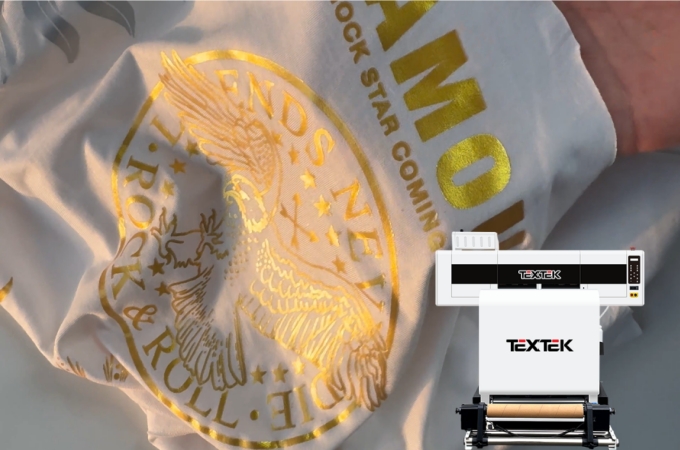18
Sep

DTF (Direct-to-Film) transfers offer an ideal way of generating bright and dense images on materials of different types. However, there is one problem that at times can be found with these prints – cracking.
Knowing the causes of cracking is crucial to avoid it and achieve longevity in the process. Some of the main causes of cracks in the design include wrong curing technique. It can also be caused by poor-quality film and insufficient pressure. At times, improper temperature setting during transferring could also be the reason.
In this article, we'll be looking at the causes of DTF transfer cracks. More importantly, we will also discuss how to prevent it.
The knowledge of DTF transfer cracks is significant in producing long-lasting prints. The presence of cracks in designs can be unpleasing to customers. They may also cause deterioration of products, hence incurring losses. Some of these include improper heat settings, poor quality of materials, or pressure when applying the coating.
If you know the causes of cracking, then you can prevent it. It also enables you to solve problems and enhance your production. This will also ensure that excellent quality work is produced. Knowing about these problems and their solution can help you achieve your desired DTF prints. It can prevent you from incurring costly problems, regardless if it is for business or personal use.
Check out these 6 of the most common causes of DTF transfer cracks and how to solve them.
Cause: Curing is the final step of using heat transfer. This is where the ink sticks on the DTF film. If the curing time is too short, the ink does not have enough time to adhere. This often results in the formation of cracks. Over-curing, on the other hand, causes the ink to brittle. This often results in cracks and damage.
Solution: Ensure that the curing time and temperature match the recommendation of the manufacturer. This is especially important when one is using a heat press as it comes with a timer that guarantees the right curing time. The curing settings should be periodically changed to determine the right settings for the equipment and the materials being used.
Cause: If the temperature being used is low, probably, the ink will not be properly transferred to the material, hence poor adhesion. High temperatures deteriorate the stability of the ink and make it brittle. The same case when it comes to pressure. If the pressure is too high or too low, the adhesive won’t stick properly.
Solution: Employ a heat press that has good temperature and pressure control. The ideal temperature is usually between 160-180 °C. Also, ensure to calibrate your press from time to time to ensure accuracy.
Cause: Applying low-quality DTF films or inks means can also cause cracks. The material will not bond well with the films or ink and the surface cracks when stretched or worn. The ink or film may not be able to resist the heat and pressure needed for proper bonding.
Solution: Ensure that you use good-quality DTF film and ink. It is advisable to check on the reviews. You should also test the material before carrying a mass production. You should also check the compatibility of the printer, ink, and film. This will ensure that you get prints that will not fade easily.
Cause: This happens if the fabric/material is stretchy or elastic. It becomes extremely easy to pull the fabric after the transfer process. This could lead to cracking of the design.
Solution: It is essential to allow the material to cool for some time after using it. This will ensure that the design does not stretch. For materials that are stretchable such as spandex or polyester, stretchable inks should be used. Fabrics should also be pre-heated to minimize stretching after the transfer.
Cause: Long-term use and frequent washing cause wearing problems. With sunshine and other wearing factors, you can easily find small splits in the DTF print. Especially, if it has been done in a wrong way. Other things such as the use of strong detergents or washing the surface at high temperatures also cause cracking.
Solution: Inform customers on the proper care to be taken in handling the product. Wash them with cold water and air the garments instead of drying them. Furthermore, it is recommended to test your designs under different circumstances. This can help you determine the durability of the designs.
Cause: If the material has moisture during the transfer process, it may hinder the adhesion of the DTF print. Steams are formed during the heat application. This results in spaces between the formed film and fabrics. Hence poor bonding and cracks.
Solution: It is important to pre-press the fabric for some time before applying the transfer. This is to remove excess moisture. This will provide a flat surface for the DTF design to be printed on. Hence, avoiding cases of the design cracking due to moisture.
Cracks on DTF transfers are a common problem that must be avoided. Doing so can help us achieve quality and long-lasting prints. Some of the causes include improper curing of the material and wrong setting of temperature and pressure. Other causes are using low-quality material, stretching of the fabric, normal wear and tear, and moisture.
With this information and implementing correct measures like correct equipment setting, correct choice of materials, and correct washing and care, the problem of cracking can be kept to a minimum. Using these techniques will help extend the durability of the prints. It will also increase the satisfaction level of clients.
Drop us an email and let's make great things happen: info@textek.com
Contact us through WhatsApp and let's talk furthermore: +8619137185989
.jpg)
